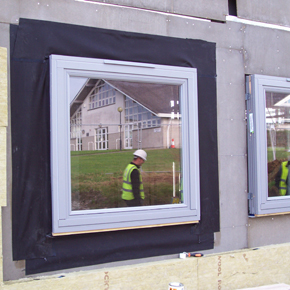
Passivhaus: It’s all in the seal
Guest blog: Malcolm Taylor, Product Manager, REHAU
So much effort has been put into educating specifiers about the benefits of Passivhaus construction by companies like REHAU that there is now a really vibrant community of advocates and supporters driving the expansion of the sector.
 Where I think more effort now needs to be focused however, is in educating installers both about the opportunities which this sector presents and the specific technical demands, so that we build sufficient competent and experienced capacity in the market.
Where I think more effort now needs to be focused however, is in educating installers both about the opportunities which this sector presents and the specific technical demands, so that we build sufficient competent and experienced capacity in the market.
REHAU’s focus of course is on the correct installation of our Passivhaus certified windows and doors, with the overriding consideration being to ensure that the windows are air tight in a way which is not required in a conventional installation.
We advise that the most effective method of sealing a window is with a three level system which provides an external breathable weather tight seal, thermal (and sound) insulation to the area between the frame and reveal, and an internal airtight seal. This follows the principle of ‘inside tighter than outside’ which allows the natural pressure gradient to move air and moisture vapour to the outside of the construction and avoids condensation and potential mould damage.
For the external breathable seal, specialist foam tapes are available impregnated with resins which improve their resistance to weather ingress. These provide a high level of driving rain resistance, but are vapour permeable, allowing any trapped moisture to escape to the outside and, with the tape set back from the joint face, they form an unobtrusive seal.
Intelligent Flexible Membranes come with a variable ‘sd’ value (vapour diffusion-equivalent air layer thickness) and are available in different widths and with different fixing systems so that they can accommodate movement. Membranes made from EPDM (Ethylene Propylene Diene Monomer) have been used for years both externally to provide protection against the weather and UV and internally for airtightness. The material is available in thicknesses between 0.7 – 1.25mm generally, but the most popular for interface sealing is 0.70 – 0.75mm. This is usually considered strong enough and is more easily formed at corners and around brackets than the thicker options.
 Internally, it’s often necessary to patch the membrane over a bracket to maintain the continuous air tight seal which Passivhaus specifications demand.
Internally, it’s often necessary to patch the membrane over a bracket to maintain the continuous air tight seal which Passivhaus specifications demand.
All too often, the middle insulation area is given less consideration than for weather or airtightness but avoiding thermal bridging here is a fundamental consideration, as is maximising acoustic insulation.
There are also specially formulated impregnated tapes available which our experience shows can actually do the job of three separate products. Not only do these combined tapes achieve the three level sealing required but they can typically be installed in only 20% of the time taken to install three products.
REHAU presented a seminar on this topic at this week’s Passivhaus Conference at the London Business Centre and the positive response and the number of questions it raised suggested that there is a real desire from installers to learn more which is very encouraging.
Latest news

26th July 2024
Enfield Speciality Doors completes world-class project for Atlas Copco HQ
A rundown office and warehouse building completely transformed into a modern headquarters for Atlas Copco has been fitted with more than 120 internal fire doors from Enfield Speciality Doors.
Posted in Access Control & Door Entry Systems, Articles, Building Industry News, Building Products & Structures, Building Systems, Case Studies, Doors, Interior Design & Construction, Interiors, Posts, Restoration & Refurbishment, Retrofit & Renovation, Security and Fire Protection, Sustainability & Energy Efficiency, Timber Buildings and Timber Products, Wooden products
26th July 2024
Abloy UK launches new white paper
Abloy UK, a leading provider of security and access control solutions, has launched a new white paper.
Posted in Access Control & Door Entry Systems, Architectural Ironmongery, Articles, Building Industry News, Building Products & Structures, Building Services, Doors, Facility Management & Building Services, Health & Safety, Information Technology, Innovations & New Products, Publications, Research & Materials Testing, Security and Fire Protection
26th July 2024
MCRMA Member Profile: David Roy, Director of Roofconsult
David Roy of MCRMA member company Roofconsult has more than 50 years’ experience to draw upon working in the building envelope sector and a unique perspective on how it has changed in that time.
Posted in Articles, BIM, Infrastructure & CAD Software, Building Associations & Institutes, Building Industry News, Building Products & Structures, Building Services, Building Systems, Cladding, Information Technology, Restoration & Refurbishment, Retrofit & Renovation, Roofs, Walls
26th July 2024
Strand: Enhancing Door Functionality and Safety
Craig Fox, Sales Director for Strand Hardware, outlines how door industry professionals might apply door limiting stays…
Posted in Architectural Ironmongery, Articles, Building Industry News, Building Products & Structures, Building Services, Doors, Facility Management & Building Services, Health & Safety, Restoration & Refurbishment, Retrofit & Renovation
 Sign up:
Sign up: